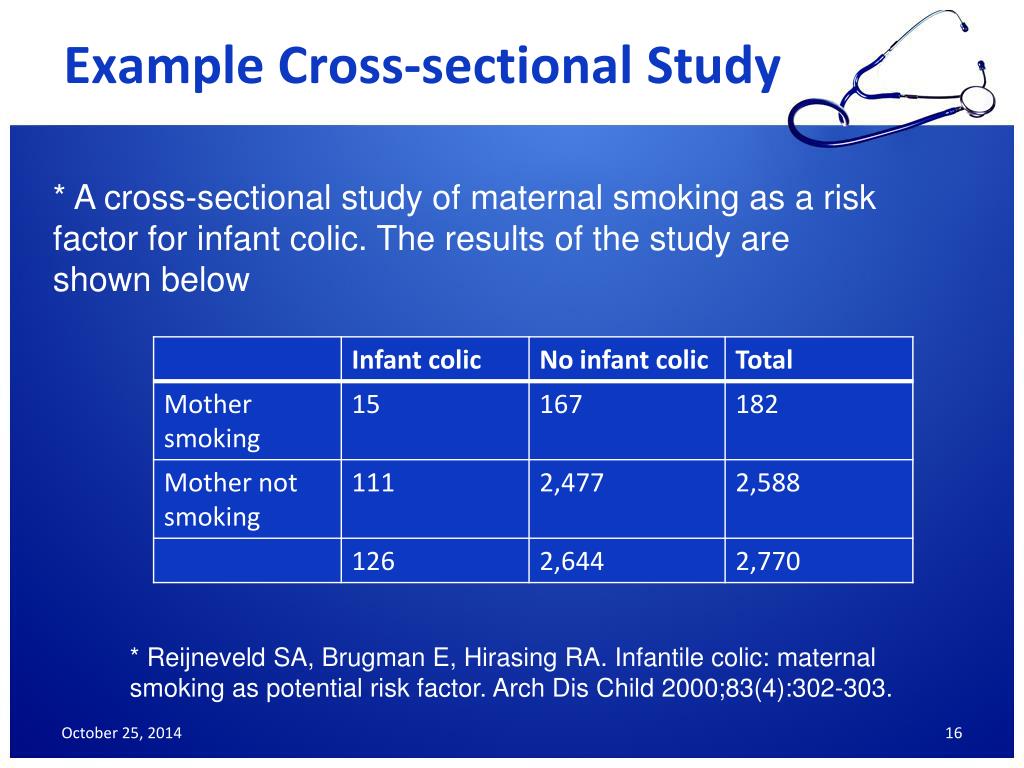Table Of Content

One of the primary benefits of cross-sectional studies is their cost-effectiveness compared to longitudinal studies. Since they are conducted at a single point in time and do not require follow-ups, the financial resources, time, and logistical efforts needed are considerably lower. This efficiency makes cross-sectional studies an appealing option for researchers with limited budgets or those seeking preliminary data before committing to more extensive research. In economics, a cross-sectional survey can provide snapshots of employment trends within a specific region or sector. An example might involve analyzing the employment rates, job types, and economic sectors in a country at a given time. This data can reveal insights into the economic health, workforce distribution, and potential areas for economic development or policy focus, informing stakeholders and guiding decision-making processes.

Frequently asked questions about cross-sectional studies
High use of ceftriaxone, metronidazole and other beta-lactam antibiotics in the wards is of great concern. The emergent of highly resistant burgs will likely render our last line treatments ineffective [10, 21, 22]. Probably the one health approach is such an ideal strategy as AMR affect humans, animals and the environment [27]. The INACSL guidelines, revised in 2023, added professional development, suggesting that instructors should strive to provide high-quality simulation education that reflects the needs of learners with new knowledge related to simulation [4]. Therefore, in addition to theoretical preparation for professional development before starting simulation education, it seems necessary to participate in practical training to experience the role of learner and educator.
Council Confirms No Decision Made On N24 Cahir-Limerick Junction Cross-Section Road Component - Tipperary Mid West Radio
Council Confirms No Decision Made On N24 Cahir-Limerick Junction Cross-Section Road Component.
Posted: Tue, 19 Dec 2023 08:00:00 GMT [source]
Examples of Cross-Sectional Data
For web, the landing page was displayed in English initially but included banners at the top and bottom of the page that allowed respondents to change the displayed language. Once in the survey, a dropdown button at the top of each page was available to respondents to toggle between languages. Considering changing behavior is crucial, we propose further qualitative and behavioral studies in-order to further explore barriers and facilitators relating to healthcare workers capability, opportunity and motivation to change. This will ensure that the AMS behavior change interventions for improving prescribing practices are not only robust but also sustainable. We further recommend control of use of watch and reserve antibiotics through policy and adopting up to date clinical and practices.
Participants
For example, a cross-sectional study could be used to investigate whether exposure to certain factors, such as overeating, might correlate to particular outcomes, such as obesity. In epidemiology and public health research, cross-sectional studies are used to assess exposure (cause) and disease (effect) and compare the rates of diseases and symptoms of an exposed group with an unexposed group. An initial adult base weight was calculated for the cases with a completed extended interview as the product of the truncated number of adults in the household (max value of 3) and the household weight. To maximize response, the survey used a sequential mixed-mode protocol in which sampled households were first directed to respond online and later mailed a paper version of the questionnaire if they did not respond online.
They may be conducted either before planning a cohort study or a baseline in a cohort study. These types of designs will give us information about the prevalence of outcomes or exposures; this information will be useful for designing the cohort study. However, since this is a 1-time measurement of exposure and outcome, it is difficult to derive causal relationships from cross-sectional analysis. Furthermore, we will also be able to estimate the odds ratios to study the association between exposure and the outcomes in this design. This study analyzed the relationship between simulation design, flow, and simulation educational satisfaction based on NLN/Jeffries simulation theory [14] and previous studies to identify factors related to nursing students’ simulation educational satisfaction. The study revealed that simulation design, flow, and simulation educational satisfaction are positively related and that flow has a partial mediating effect on the relationship between simulation design and simulation educational satisfaction.
In this study, researchers examine a group of participants and depict what already exists in the population without manipulating any variables or interfering with the environment. A pre-incentive of $2 (in the form of two $1 bills) was sent to all sampled addresses with the first letter, which provided information about how to complete the survey online. This and subsequent screener invitations only referred to the pre-incentive without reference to the possibility of later promised incentives. A cross-sectional study is essential when researching the prevailing characteristics in a given population at a single point in time. Cross-sectional studies are often used to analyze demography, financial reports, and election polls.
RCTs are given the highest level because they are designed to be unbiased and have less risk of systematic errors. Cross-sectional studies can be either qualitative or quantitative, depending on the type of data they collect and how they analyze it. Often, the two approaches are combined in mixed-methods research to get a more comprehensive understanding of the research problem. Researchers are able to look at numerous characteristics (ie, age, gender, ethnicity, and education level) in one study.
Cross-sectional vs. longitudinal studies
Typically, these studies are used to measure the prevalence of health outcomes and describe the characteristics of a population. It provides a snapshot of the characteristics of the population at a single point in time. A number of sensitivity checks were performed to test the robustness of the findings, and the main conclusions were consistently upheld. Each sampled mailing address was assigned to one of four categories according to its final screener disposition. The mail and web screening and extended surveys were developed in English and translated into Chinese (Simplified and Traditional), Hindi, Korean, Tagalog and Vietnamese.
Describe the characteristics of a community
The more immersive the simulation class, the greater the satisfaction with simulation-based education. Studies have shown that flow has a partial mediating effect between VR simulation design and educational satisfaction [17] and between simulation design and satisfaction and self-confidence [18]. The simulation design seemed to induce learners to flow into the simulation, which increased their simulation educational satisfaction because they performed well once they engaged in the simulation activity. The simulation educational satisfaction score in this study was 62.90 ± 6.93, which was higher than the scores of 57.12 ± 8.21 [8] and 57.26 ± 6.53 [17] in previous studies using the same scale. The higher the satisfaction with the major, the higher the satisfaction with clinical practice [25], and the higher the satisfaction with university life, the higher the simulation educational satisfaction. In a previous study, only 47.5% responded that they were satisfied with their university life [8].
Although they are both quantitative research methods, there are a few differences when comparing and contrasting cross-sectional and longitudinal studies. With a single cross-sectional survey, you can gather comprehensive information about your customers' characteristics, the types of sports that they like to play and watch, and their reactions to some of your current product offerings. One of the major uses of cross-sectional research is to assess the traits or qualities of a specified population. For that reason, these studies often gather multiple pieces of demographic data or other data that will enable you to draw up a picture of your target population.
Hospital/ward/patient-level data was collected in June 2022 using standardized GPPS patient and ward forms (see in the appendix). The ward form extracted denominator data which comprised all inpatients present in the specific ward before 8 A.M. The patient form captured the numerator data of all admitted inpatients receiving an “active/ongoing” antimicrobial prescription at 8 A.M on the day of the GPPS. Data extracted include details on antimicrobial agents, indications, diagnosis and a set of quality indicators such as stop/review date and compliance to the guidelines.
Also, you can find advanced data analysis tools such as trend analysis and dashboards to visualize your information and do your own cross-sectional studies simply and efficiently. Research by a phone manufacturer throughout the target demographic market validates the expected adoption rate and potential phone sales. In cross-sectional studies, researchers enroll men and women across regions and age ranges for research. Researchers usually use descriptive and analytical research methods in real-life cross-sectional studies. We’ll review examples and explain the types of cross-sectional studies you might perform. We’ll also take a closer look at the benefits of this valuable research for the work you do.
A researcher might collect cross-sectional data on past smoking habits and current diagnoses of lung cancer, for example. While this type of study cannot demonstrate cause and effect, it can provide a quick look at correlations that may exist at a particular point. Another example of a cross-sectional study would be a medical study examining the prevalence of cancer amongst a defined population. The researcher can evaluate people of different ages, ethnicities, geographical locations, and social backgrounds.
In nursing, simulation education has many advantages, such as improving nursing students’ problem-solving and judgment skills. Simulation education satisfaction is an indicator for evaluating educational performance from the learners’ perspective and an important criterion for the development and progress of nursing education. Therefore, based on NLN/Jeffries simulation theory, this study aims to identify the relationship between simulation design and educational satisfaction and to confirm the mediating effect of flow. Think of a cross-sectional study as a snapshot of a particular group of people at a given point in time. For example, a cross-sectional study might be used to determine if exposure to specific risk factors might correlate with particular outcomes.

No comments:
Post a Comment